
Welcome, from sunny Australia!
Other Tuning

Other Tuning
On top of the usual selection of cams & so on, you also have to look at the timing of the cams, lengths of inlet and exhaust manifolds, etc. What I've done - hopefully - is to try to put together a page that gives a generalisation of what happens when you alter cam timing, inlet, and exhaust lengths.
The data that I'm using here is generated by Engine Analyser Pro 2.1, which is supposed to be 95% accurate. Whilst I would not trust it totally to give 95% accurate absolute power figures, I would put some trust in relative power figures, and what I mean by that is that if for example you advance the inlet cam timing as I do below, then if the data says that the power goes up by 5hp at such-and-such a revs, then it'll be very close indeed to that increase. That's a relative difference, 5hp, though in the real world the engine may go from say 150hp to 155hp or it may go from 145hp to 150hp, etc.
The base engine that I used in the computer simulation of all this data is the generation four 3SGE that's going into my Fraser Clubman, and the results here are the product of hours of fiddling with cam timing, inlet and exhaust lengths, and so on.

* Note that with all these 'dyno runs'
that they are only a generalisation, and it's very important to
remember that with your engine you will get different results.
But the trend should be similar to what you see here.
* With each 'dyno run' the 'current' data
is the one that's being described and the 'last' data is for the base
engine as you see above.
| Inlet cam advanced 10° Let's advance the inlet cam first - You can see how the bottom-end and top-end power has dropped away a little, but the mid-range has picked up. This is a the start of how the various variable cam timing systems around the world work. (See here for more info) Also note that the 10° is measured on the lobe centres, and so that's 20° on the crankshaft timing, total. |
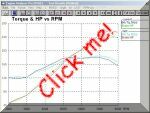 |
| Inlet cam retarded 10° Here's the inlet cam retarded, and you can see that pretty much the opposite has happened to the advanced cam power run. |
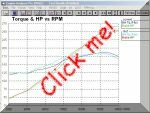 |
| Exhaust cam advanced 10° The inlet is back to normal, but now the exhaust is advanced and you can see that there's a touch more bottom-end power but as soon as the engine starts to get up on the cams there is a bit less power than there was before at most revs. (Again a reminded that this is a generalistaion, and other engines may have a greater or lesser effect like this) |
 |
| Exhaust cam retarded 10° This is with the exhaust retarded and you can see that it kills the bottom-end power, has a touch more mid-range and slightly less top-end. I think that perhaps the reason I got this particular result is that with the base engine I worked on I found a 'sweet spot' for the exhaust cam, and if it's moved too far either way then it tend to make the power curves a bit more 'bumpy'. |
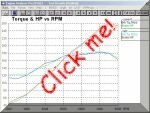 |
| Total cam advance 10° Both cams advanced by 10°, as if you had a single camshaft - So this data should be typical for such engines. You can see that up to about 6300rpm there's a little more power everywhere, but not a great deal. After that, the power drops off. |
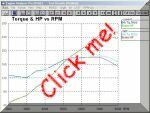 |
| Total cam retard 10° Both cams retarded by 10°, and there's a power loss pretty much everywhere except for the last thousand revs or so. |
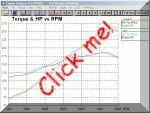 |
Some thoughts on the results above ...
1. Moving the inlet cam around has a greater
effect than for the same amount for the exhaust.
2. Advancing the inlet and retarding the
exhaust gives more mid-range power, at the expense of bottom-end and
top-end.
3. If you want power over a narrow band,
then there's a lot to be gained by playing with the cam timing.
4. This is why variable cam timing is a good
thing for making a wider torque curve, and hence making the engine more
driveable. Examples of these engines are the Toyota 20 valve 4AGE,
generation four 3SGE, Honda S2000 engine, etc.
I also got some data on inlet and exhaust
lengths.
Once again, this is a generalisation, so
although it should work much the same for your engine you will
get different results.
Some thoughts on the results above ...
1. Longer manifolds make more power in the
low-end to mid-range revs.
2. If the manifolds are an odd length then
you'll get odd 'bumps' in the power curve. By odd I mean that it has
bumps & dips instead of having a smooth delivery.
3. This is why some engines (Toyota
generation three 3SGE, etc) have variable length inlet manifolds, to
again widen the torque curve. Formula One engines also use a variable
length inlet system, but unlike the relatively crude Toyota system they
employ an infinitely variable length (within certain limits of course)
inlet system to make the engines work over another one or two thousand
revs.
Final thoughts ...
The only way to get the best results
is to spend lots of time on a dynomometer. The examples I've used above
are for just one engine and so as I keep saying you'll get different
results for different engines. For example, the results from a different
length inlet manifold may well be masked by a poorly shaped airbox
& filter.
I would suggest that if you want to try
different length inlet manifold - a good idea! - then the way to do it
would be to start off with the shortest one that you can make, then use
0.25" thick spacers to make it longer in stages to see the results.
The exhaust is a little less 'fussy', as you
can see from the above 'dyno runs', but you can still do the same thing
although with much greater difficulty - Again start off with the
shortest set of pipes that you can get away with, then weld on 1"
lengths to make them longer. You'll of course have to make the single
pipe after the collector shorter by an inch a time as well ... ;)
For more motorsport links, try the motorsport section on my links page.
Back to the Index page
Page & contents where applicable © Bill Sherwood